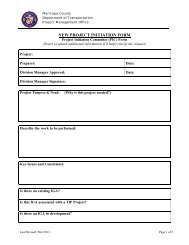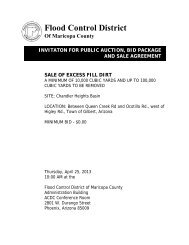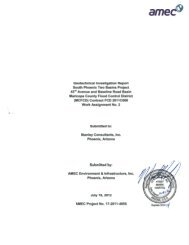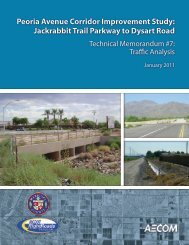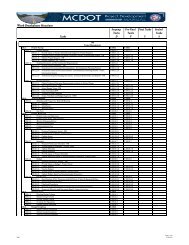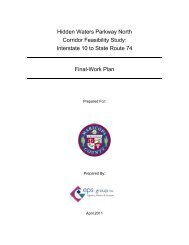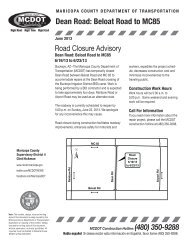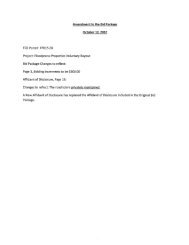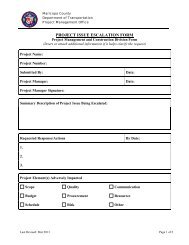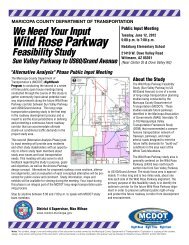Drainage Overview - Maricopa County Department of Transportation
Drainage Overview - Maricopa County Department of Transportation
Drainage Overview - Maricopa County Department of Transportation
You also want an ePaper? Increase the reach of your titles
YUMPU automatically turns print PDFs into web optimized ePapers that Google loves.
(PMF) events were also calculated for the future land use condition. SCS Type II rainfall<br />
distribution was used for the 24-hour storm.<br />
Subbasin boundaries were placed along the CAP canal alignment so that the effects <strong>of</strong> the<br />
structure could be included in the model, but most roadways, including US 60, State Route<br />
74, and Sun Valley Parkway, were ignored. Rainfall losses were estimated using the Green<br />
and Ampt infiltration equation. The S-Graph method was found to be the most appropriate<br />
method developing unit hydrographs.<br />
Normal depth channel routing methodology was utilized in the hydrologic model to route<br />
surface run<strong>of</strong>f through subbasins. An eight-point composite channel cross-section was<br />
developed to represent typical wash cross-section conveyance. The longitudinal slopes and<br />
Manning’s “n” values were estimated based on topographic mapping, aerial photographs,<br />
and field reconnaissance estimates. Storage routing behind the CAP canal was modeled<br />
using level pool routing. Most flow splits were not considered important for the purposes<br />
<strong>of</strong> this model. One flow split upstream <strong>of</strong> the CAP and east <strong>of</strong> US 60 was included, which<br />
directs some flow into the study area and some flow away from the study area.<br />
4.2 Offsite Hydrology Results<br />
Detailed hydrologic analysis was not performed as part <strong>of</strong> this study. The existing peak 100-year<br />
flows for each major wash crossing within the study area depicted in Figure 6 are listed in Table<br />
2. The wash information presented previously is also included to provide a comprehensive<br />
summary <strong>of</strong> the <strong>of</strong>fsite hydrology at each wash crossing. Table 2 indicates if the peak flow was<br />
taken directly from an existing study or if the discharge was calculated by combining peak flows<br />
<strong>of</strong> published values. Combined values are conservative as the peak flows generally do not occur<br />
at the same time. The concentration point or subbasin identification and storm duration used in<br />
each existing study are also presented. Excerpts from the original source documents <strong>of</strong> each<br />
respective hydrologic study are included in Appendix TM3-10.<br />
As stated previously, concentration points were located at USGS “blue lines” and 100-year<br />
floodplains. There is no discharge reported for Wash 4 (Crossing 9). Because <strong>of</strong> the distributary<br />
nature <strong>of</strong> the area, it is difficult to determine the area contributing to this wash.<br />
Trilby Wash (Crossing 14) has a published effective FEMA discharge that differs from the value<br />
reported in the Wittmann ADMSU. The peak flows presented for this crossing in Table 2 report<br />
both the effective FEMA discharge from the Flood Insurance Study (FIS) as well as the discharge<br />
from the Wittmann ADMSU. The effective FEMA discharges reported in the FIS for Trilby<br />
Wash are higher than those published in the Wittmann ADMSU. It should be noted that the<br />
drainage areas recorded in the FIS are also significantly larger than the drainage areas in the<br />
Wittmann ADMSU.<br />
091337137, 2011-018, TT005 <strong>Maricopa</strong> <strong>County</strong> <strong>Department</strong> <strong>of</strong> <strong>Transportation</strong><br />
Technical Memorandum 3 Deer Valley Parkway Feasibility Study<br />
<strong>Drainage</strong> <strong>Overview</strong> 23 April 2012





